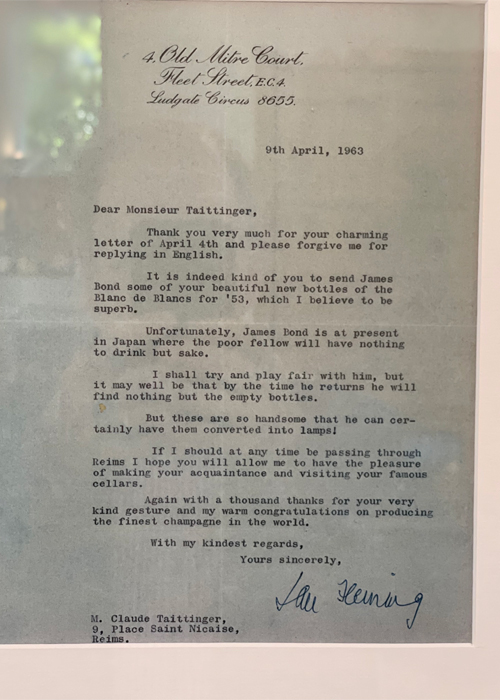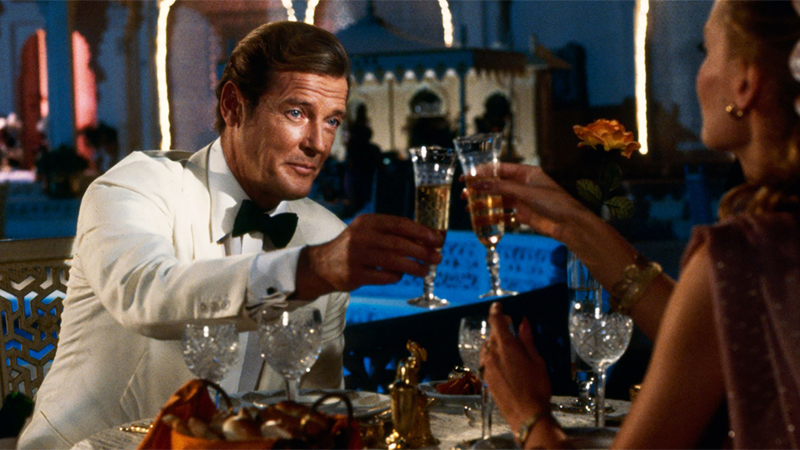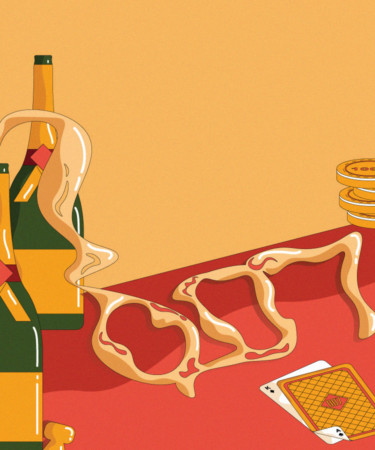While the vodka Martini is definitely what James Bond drinks when he’s steeling himself for the next kill (“shaken, not stirred” — legendary), it’s Champagne that the fabled MI6 agent goes for when he’s off the clock or looking to make a different type of strike. There’s Champagne with caviar on the train, Champagne late at night with bacon and eggs, Champagne at the baccarat table in between hands, Champagne on the deck of the QE2 — Champagne undeniably flows through the life of 007.
But which bubbly brand does Bond like to drink? “Only the best” is what you would expect from a man who has refined tastes and a voracious appetite. Taittinger, Veuve Clicquot, Dom Pérignon, and Bollinger all feature in the Bond series, and almost always in situations involving some beautiful agent, either friendly or a member of the opposition.
Ian Fleming, author of the “Bond” series, was an enthusiastic Champagne drinker. In the luxurious offices of Maison Taittinger in Reims, a framed letter from Fleming to Mr. Taittinger can be found on the wall of an elegant meeting room. In the letter, Fleming, who had received a case of Taittinger’s latest vintage Champagne, wrote: “It is indeed kind of you to send James Bond some of your beautiful new bottles of the Blanc de Blancs for ‘53, which I believe to be superb. … I shall try and play fair with him, but it may well be that by the time he returns (from Japan) he will find nothing but the empty bottles.”

Bond will occasionally have Champagne solo with a meal, in a new hotel room, or when sitting down for an elegant business dinner (as in “Dr. No” and “Goldfinger”), because he enjoys treating himself to fine food and drink: “I take a ridiculous pleasure in what I eat and drink. It comes partly from being a bachelor, but mostly from a habit of taking a lot of trouble over details,” the character declares in “Casino Royale.” But if he accepts bubbles as the mark of a well-heeled, worldly gentleman, 007 is prone to using Champagne much more often as a tool of seduction.
In many of the books, Bond often enjoys Taittinger, a Champagne that he calls “probably the finest in the world.” In “Casino Royale,” Fleming’s first book (and one of the last Bond films in the Broccoli series starring current 007 Daniel Craig), Bond starts his evening in the casino over dinner with the beautiful Vesper Lynd. They drink cold vodka to break the ice while they order their meal, and then Bond gets down to business.
“If you agree,” said Bond, “I would prefer to drink champagne with you tonight. It is a cheerful wine and it suits the occasion — I hope,” he added.
With his finger on the page, Bond turns to the sommelier: “The Taittinger ‘45?”
“A fine wine, Monsieur,” said the sommelier. “But if Monsieur will permit,” he pointed with his pencil, “the Blanc de Blancs Brut 1943 of the same marque is without equal.”
Bond smiled. “So be it,” he said.
“That is not a well-known brand,” Bond explained to his companion, “but it is probably the finest champagne in the world.”
Hours later, after winning a major hand against his evil counterpart Le Chiffre at the baccarat table, Bond settles into a cozy booth in the casino’s Roi Galant Lounge, again with Lynd. — “They were given a corner table by the door. Bond ordered a bottle of Veuve Clicquot and scrambled eggs and bacon.” — Bubbles and breakfast before heading back to the room? Not a bad way to ease into the end of the night.
Dom Pérignon finally shows up in book three, “Moonraker.” Bond has been invited by his boss, M, to the exclusive London men’s club Blades. M has recruited Bond, a skilled card sharp, to play against the story’s villain, Hugo Drax, who is believed to be a serial cheater. Bond, happily embracing the challenge, decides to drink some bubbles while planning his strategy to defeat the billionaire. Bond asks M if he’d like to join him. M responds:
“Champagne? Personally I’m going to have a half-bottle of claret. The Mouton-Rothschild ‘34, please, Grimley? But don’t pay any attention to me, James. I’m an old man. Champagne’s no good for me. We’ve got some good champagne, haven’t we, Grimley? None of that stuff you’re always telling me about, I’m afraid, James. Don’t often see it in England. Taittinger, wasn’t it?”
Bond smiled at M’s memory. “Yes,” he said, “but it’s only a fad of mine. As a matter of fact, for various reasons I believe I would like to drink champagne this evening. Perhaps I could leave it to Grimley.”
The wine-waiter was pleased. ‘If I may suggest it, sir, the Dom Pérignon ‘46. I understand that France only sells it for dollars, sir, so you don’t often see it in London.”
A rare Dom Pérignon is clearly an exclusive benefit in a very exclusive club. This happens to be the only reference to Dom Pérignon in the entire Fleming series, but the top Moet cuvée will later become a favorite in the movie versions.
In “Diamonds Are Forever,” Veuve Clicquot shows up again, this time the rosé bottling. Bond is having dinner with Tiffany Case when they decide to order Clicquot Rosé. — “The wine waiter brought the champagne and Bond tasted it. It was ice cold and seemed to have a faint taste of strawberries. It was delicious.” — They finish dinner with some Stingers ordered by Miss Case. If Champagne often plays the role of romantic interlude drink of choice, hard alcohol never seems to be fully off the menu. And as the story comes to a close on the QE2, Bond receives in his room a platter of small steak toasts along with a bottle of bubbles sent by Case:
“There was a quarter bottle of Bollinger, a chafing dish containing four small slivers of steak on toast canapés, and a small bowl of sauce.” (Note that the Champagne is chosen by Case, not by Bond. It’s the only mention of Bollinger in the books. The iconic house, first Champagne to receive a Royal Warrant from her Majesty the Queen of England, will play a key role in the later Bond films.)
A sprinkling of other Champagne brands appear in the later books, including Pommery Rosé in “Goldfinger” (chosen by Bond’s dinner partner), Pol Roger ordered by “the girl” in “On Her Majesty’s Secret Service,” and a half-bottle of Krug ordered by Bond in the same book. So it’s clear that Fleming likes to try new things, but in the end, he mostly falls back on his favorite, Taittinger Blanc de Blancs.

When Albert Broccoli bought rights to the Fleming series in 1961, Bond’s taste for Champagne was set to continue in the films. The big winner at the beginning of the movie series was Dom Pérignon, the iconic prestige cuvée of the Moët Champagne house. In “Dr No,” the first movie of the Eon series that now hits 25 with the release of the current “No Time to Die,” Dom Pérignon, or DP, shows up on the dinner table of Dr. No where Bond and Honey Ryder are now the evil doctor’s prisoners. When Dr. No appears to threaten the beautiful if naïve Ursula Andress, 007, played by Sean Connery, grabs the bottle of DP from its bucket and is prepared to use it as a weapon. Quickly subdued, Bond has to listen to Dr. No tell him that it would have been a pity to break the ‘55 Dom Pérignon. Bond casually replies that he enjoys the ‘53 himself. (It’s interesting to note that in “Dr. No” the book, there is no reference to Champagne. The choice of Dom Pérignon, then, must have been made by either the director or Broccoli, the producer.)
The next film, the classic “From Russia with Love,” opens with Bond and a companion on a blanket by a river, doing more than just picnicking. He reaches down to a string attached to a toe and proceeds to pull out of the water a bottle of Taittinger Comtes de Champagne that has been chilling in the nearby stream. Once again, bubbles and beauty is the pairing of choice.
Then things take a hard turn towards Dom Pérignon. Over the course of the next eight films, from “Goldfinger” to “The Spy Who Loved Me,” DP practically dominates the big screen. In “Goldfinger,” DP ‘53 in the bedroom is almost served too warm, which allows Bond to joke: “My dear girl there are some things that just aren’t done, such as drinking DP ‘53 above the temperature of 38 degrees Fahrenheit. That’s as bad as listening to the Beatles without ear muffs.”
In “Thunderball,” DP ‘55 is the celebration Champagne with Beluga caviar after Bond defeats Emilio Largo at cards in the casino.
We then shift to a younger vintage, with Mr. Osato offering Mr. Fisher (Bond’s cover) a glass of DP ‘59 in “You Only Live Twice.”
In “On Her Majesty’s Secret Service,” 007 pairs a taste of the ‘57 with Contessa Teresa to some Royal Beluga caviar in their suite. Later, up in the mountain lair of the evil Blofeld, Dom Pérignon is offered to Bond as they watch the dawn. The DP becomes a weapon when Teresa takes on Blofeld’s henchman with a broken bottle.
In “Live and Let Die,” Bond enjoys Champagne on a picnic blanket with a beautiful woman, who turns out to be a double agent — DP again.
Then in “Man with the Golden Gun,” 007 is greeted on the beach by the white-tuxedoed henchman Nick Nack, who offers him ‘64 DP opened by the villain Scaramanga with a gunshot. Unfazed Bond replies, “I prefer the ‘62 myself. Still, beats a bag of peanuts.”
In “The Spy Who Loved Me,” Roger Moore drives his white Lotus out of the water onto a beach of mesmerized sunbathers and then finds DP in an ice bucket in his hotel room. We find overall 10 direct references to Dom Pérignon, along with a bunch of other visual appearances.
And then, in “Moonraker,” 007 switches to his current fave, Bollinger. Bollinger, famed for its wines of a certain power, thanks to the prominence of Pinot Noir in the blend, becomes 007’s exclusive Champagne of choice.
The 1979 film opens with Bond cavorting with a beautiful woman in a private jet. An ice bucket stamped ‘Bollinger’ filled with two bottles is prominent in the foreground. They may or may not have been emptied before Bond and the other agent jump out of the plane for the opening parachute sequence. Later in the film, as 007 arrives at his hotel in Venice, he turns to the sexy Dr. Holly Goodhead and, in what must be one of the most campy lines in the entire Bond film series, says, “Bollinger! If it’s ‘69, you were expecting me.”
In “A View to a Kill,” 007 tastes and calls the vintage on a bottle of Bollinger 1975 and then moves on to some Château Lafite 1959 while dining in the Eiffel Tower’s Le Jules Verne.
In “Goldeneye,” he enjoys the great Bollinger vintage 1988.
And in his hotel in Hong Kong in “Die Another Day,” Bond orders up some bubbles from room service: “And if there’s any left, the ‘61 Bollinger.” Guess he’s been regularly depleting their stocks.
The current state of affairs is a bit different, maybe not as bubbly. As current Bond Daniel Craig took over the 007 role, the references to Champagne continued, always Bollinger, always in the company of women, and sometimes still with caviar. Yet this harder Bond seems less interested in the details, the nuance, or the vintages. Champagne appears from time to time, but it’s never a topic of discussion or of witty repartee. It feels more like a tool rather than an effervescent moment. This Bond doesn’t seem to take “a ridiculous amount of pleasure” in what he eats and drinks. It’s all about the kill, no style points required beyond the Omega watch.
Well, 007, if it’s really “No Time to Die,” maybe you should start living a little again, non?
